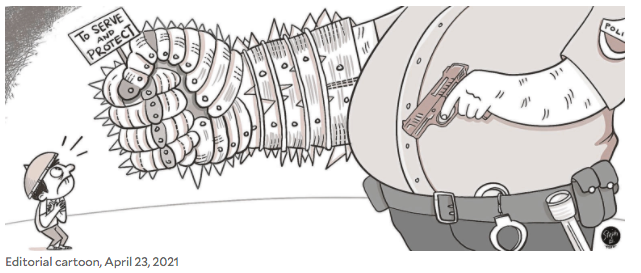A woman cried rape and robbery against 11 members of the police force in Cebu City, and was gunned down by unknown assailants a month later. A few hours on, the officer who not only led the police team’s brazen extortion but was also pinpointed by the woman as the scoundrel who raped her twice, was said to have shot himself inside the toilet of the police station.
By any measure, the circumstances of this case are baffling, appalling, and suspicious. The warrantless search of businesswoman Ritchie Nepomuceno’s home conducted by the police team on March 9, purportedly for unlicensed firearms, is common enough, if still an outrageous violation of due process. But the police misconduct didn’t end there: According to Nepomuceno in the case she filed against her tormentors, the cops also seized her valuables including jewelry and locked her up overnight in a “secret room” at the police station. The next day she was forced to withdraw P170,000 from an ATM, then the head of the team brought her to a motel where she was raped twice.
As it turned out, two other women had similar experiences with the same cabal. One of the women, who filed a complaint with the police’s Integrity Monitoring and Enhancement Group Visayas Field Unit, was illegally arrested and brought to the secret room where, she said, police choked her and attempted to dunk her plastic-wrapped head in a pail of water, to force her to confess where she had kept alleged drug money.
The secret room mysteriously vanished when the Commission on Human Rights (CHR) visited the Sawang Calero police precinct, replaced by what appeared to be a storeroom.
More mystifying was why the head of the police team, Police Staff Sergeant Celso Colita, would shoot himself in an apparent suicide—at least according to the chief of the Regional Police Drug Enforcement Unit—shortly after Nepomuceno’s killing Monday night.
Was Colita racked by guilt over what he had done—the extortion, rape, maybe even the shooting death of Nepomuceno? Did he feel remorse for his now disgraced colleagues who were relieved from their posts pending internal investigation of the case? Did he fear the legal consequences of his criminal actions? Or, as the more cynical would speculate, was he silenced by his confederates in the police racket?
Hopefully, a thorough and impartial investigation of the case would provide answers to this bloody puzzler. But then again, does one dare hope?
In July last year, the unconscionable killing of a 15-year-old girl who was gunned down on her way home from the police precinct shocked even the CHR. Fabel Pineda had filed a complaint against two cops from the San Juan, Ilocos Sur police station who she said had sexually abused her and her cousin. The police had accosted the girls for allegedly violating curfew during a party and offered to take them home. Instead, they were brought to a beach and abused.
Then Philippine National Police chief Archie Gamboa ordered the dismissal of the two officers named in the girls’ complaint and vowed to get them the “stiffest penalty” for their crimes. Six months later, in January this year, the CHR had to remind the Ilocos Sur police and the justice department that the case remained unresolved, “despite the strong condemnation of the [PNP] of the grave violation committed by their fellow men in uniform.”
CHR spokesperson Jacqueline de Guia noted that the case of Fabel and her cousin exposes the reality of threats and serious reprisals for women and girls who are abused by persons in authority or in police custody. “Such incidents are a clear betrayal of public trust by the same people who have sworn oaths to protect its citizens,” she said.
Nepomuceno’s ordeal and eventual murder likewise underscore the institutional rot in the PNP. Not one, but 13 police officers (two other cops were added to the initial list of suspects)—a whole precinct—was involved in multiple dastardly crimes, and if not for the bravery of Nepomuceno and the two other women who came forward, would have gotten away with them. Nepomuceno, already a victim many times over, had to pay the ultimate price as she fought to bring these hoodlums in uniform to justice.
How long has the Sawang Calero cops’ criminal operation been going on? How could their superiors not know? What kind of training and values have these officers imbibed in their years in law enforcement? How many more police detachments and districts across the country are engaged in similar organized lawlessness? And is the internal mechanism for complaints and redress effective at all? Such nefarious goings-on in the police force demand an unsparing, full-scale investigation, particularly in the wake of this horrendous shooting-suicide case.
